Your crypto wallet security might be weaker than you think. Bitcoin jumped from $1,000 in 2009 to $69,000 in 2021—but most people still don’t understand how crypto wallets actually work.
Here’s what you need to know: crypto wallets don’t just store your coins. They protect your private keys and give you access to the entire blockchain network. Yet 55% of people aged 30-44 and 63% of Gen X users acknowledge cryptocurrency’s practical value while missing these fundamental security basics.
The numbers tell the story. Cryptocurrency crime reached 0.34% of all transactions in 2023—meaning 99.66% of crypto activity remains legitimate. But when things go wrong, they go very wrong. FTX’s collapse in late 2022 left thousands of users with no access to their funds because they didn’t control their own wallets.
Galaxy Digital Holdings manages over $2 billion in crypto assets. The IRS now treats cryptocurrency as “convertible” currency for tax purposes. Your wallet security isn’t optional anymore—it’s essential for protecting your digital assets.
These 5 myths could be putting your cryptocurrency at risk right now.
Myth 1: Crypto Wallets Are Only for Storing Coins
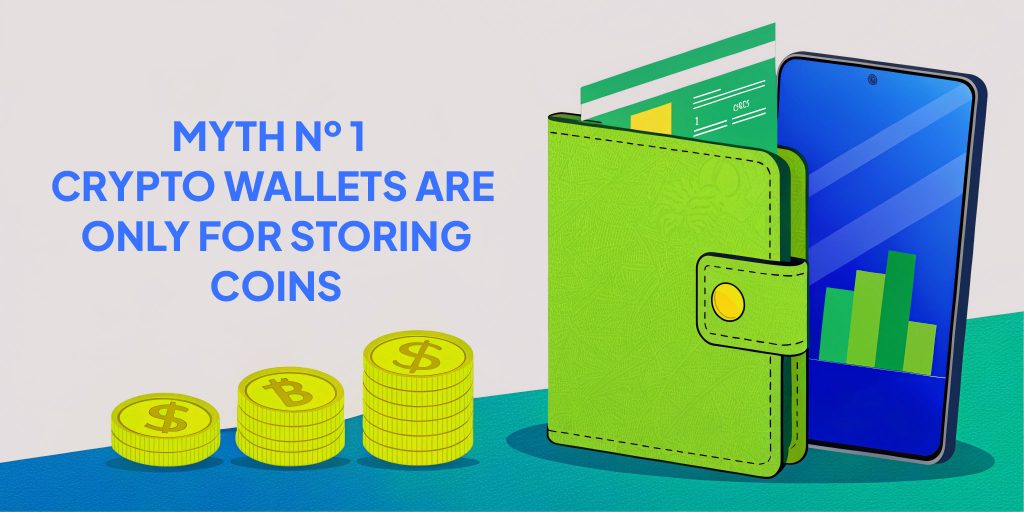
The name “crypto wallet” confuses everyone at first. You hear “wallet” and think about that leather thing in your pocket holding cash and credit cards. This simple misunderstanding creates serious security problems—and costs people money.
What the myth says
Most people believe crypto wallets work like physical wallets. You put your Bitcoin, Ethereum, and other coins inside an app or device, and they sit there waiting for you to spend them.
This leads to dangerous assumptions:
- You need to keep your computer running for your wallet to work
- Losing your wallet means losing all your coins forever
- Wallets only store cryptocurrency—nothing else matters
- All wallets do basically the same thing
Some users even think they need to keep their computers powered on 24/7 to maintain their cryptocurrency holdings. Others believe their actual coins live inside their phone or hardware device.
The truth about crypto wallets
Your crypto wallet doesn’t store any cryptocurrency at all. Instead, it stores the cryptographic keys that give you access to your digital assets on the blockchain.
Think of your wallet like a sophisticated remote control for your blockchain assets. The public key works like your account number—you can share it to receive cryptocurrency. The private key functions like your PIN code—it authorizes transactions.
Modern crypto wallets do much more than basic access:
- Stake cryptocurrencies like ETH to earn passive income
- Buy, sell, send, and swap various digital assets
- Access Layer 2 networks such as Arbitrum and Optimism
- Connect with decentralized applications across Web3
- Manage multiple assets across different blockchains
- Control your digital identity while maintaining privacy
- Access DeFi platforms for loans and financial services
Many wallets now include built-in exchanges, real-time price tracking, and portfolio management. These features transform simple access tools into comprehensive financial control centers.
Your wallet has become like a banking app—providing access to various financial services from one interface. The cryptocurrency space continues developing similar all-in-one solutions.
How to protect your wallet properly
Understanding that your wallet manages access keys—not actual coins—changes everything about security. Here’s how to protect what matters:
1. Choose the right wallet type
- Cold wallets (hardware devices) offer maximum security for long-term holdings by keeping private keys offline
- Hot wallets provide convenience for frequent transactions but need stronger security measures
2. Secure your keys properly
- Store your seed phrase offline in a secure location
- Never share your private keys with anyone
- Consider multi-signature wallets that require multiple keys for transactions
3. Enable advanced security features
- Turn on two-factor authentication whenever available
- Set up transaction notifications to spot unauthorized activity
- Update your wallet software regularly to patch vulnerabilities
4. Spread your risk strategically
- Use multiple wallets—don’t keep all assets in one place
- Maintain a dedicated wallet for experimental activities
- Use cold storage for long-term holdings and hot wallets for daily transactions
5. Stay alert to threats
- Watch for phishing attempts requesting your private keys
- Avoid public Wi-Fi when accessing your wallet
- Verify transaction details carefully before confirming
Your assets exist on the blockchain itself. Protecting the keys that grant access becomes your primary concern—not the wallet software or hardware device.
Recognize what your wallet actually does, implement proper security measures, and you can safely access the expanding Web3 ecosystem these tools now provide.
Myth 2: Mobile Wallets Are Too Risky to Use
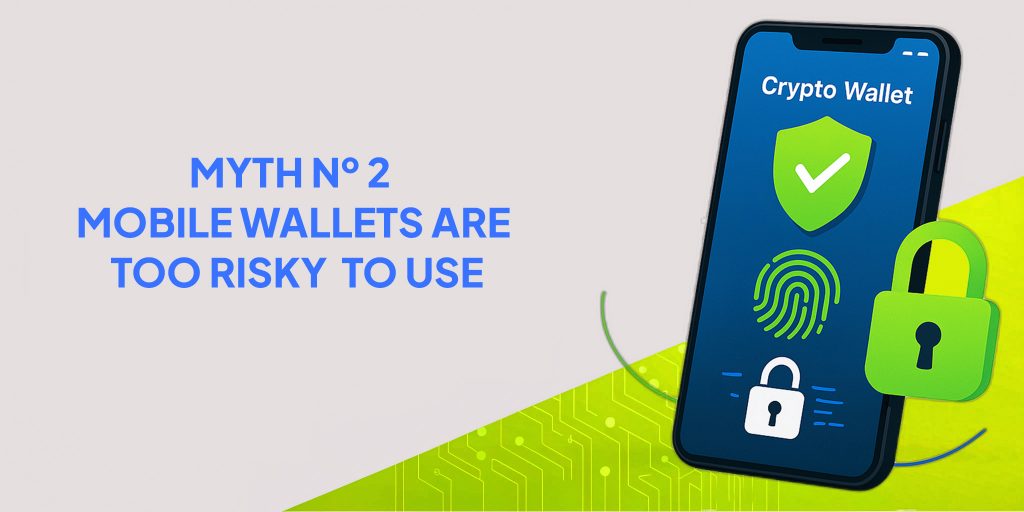
Need crypto access on the go? Mobile wallets get a bad reputation, but the reality might surprise you. This myth keeps many users from taking advantage of convenient, secure mobile cryptocurrency management.
What the myth says: Mobile Wallets Are Too Risky
Mobile wallets are dangerous. That’s what most people believe. According to this myth, your smartphone crypto wallet is:
- Constantly under attack from malware and phishing attempts
- Vulnerable to theft through public Wi-Fi networks
- A guaranteed loss if your phone gets stolen or damaged
- Less secure than desktop or hardware alternatives
- Too exposed to network spoofing and overlay attacks
Android devices face particular scrutiny. Hackers use fake interfaces to steal usernames and passwords through overlay attacks. Many wallet apps can’t detect if your device is rooted, jailbroken, or compromised.
Recent breaches make headlines and fuel these fears. Apps in Google Play and the App Store have been caught with malicious code designed specifically to steal crypto wallet recovery phrases.
The truth: Mobile Wallets Can Be Remarkably Secure
Mobile wallets offer sophisticated security features that rival other wallet types when properly configured. Their protection has evolved substantially over recent years.
Modern mobile wallets include biometric authentication—the same trusted security measure used by major financial corporations worldwide. Most now offer two-factor authentication, security key support, and encrypted recovery phrase backups.
Your mobile wallet apps operate in isolated environments. This makes cross-application malware attacks much more difficult. iPhones use secure enclaves, while Android devices employ TrustZone technology for hardware-based security.
Over 52 million Americans own cryptocurrency. Mobile platforms have responded by strengthening their security infrastructure. Popular wallets like Trust Wallet and Exodus provide QR code scanning that combines convenience with security.
Mobile wallets offer practical security advantages:
- Portability enables quick account monitoring
- Push notifications provide real-time transaction alerts
- Regular updates patch vulnerabilities promptly
- Built-in secure elements protect your private keys
Mobile wallets do present legitimate risks. They remain connected to the internet as “hot” wallets, making them more exposed to remote attacks than hardware alternatives.
How to Secure Your Mobile Wallet
Skip the fear. Focus on proper security practices instead.
1. Enable Strong Authentication.
Use biometric authentication whenever possible—fingerprint or facial recognition provides significantly stronger protection than passwords. Set up two-factor authentication through Google Authenticator, Microsoft Authenticator, or Duo Mobile rather than SMS verification.
2. Protect Your Network Connections.
Public Wi-Fi networks present major security risks due to unknown users who might include malicious actors. Use a Virtual Private Network (VPN) when accessing your wallet in public. VPNs encrypt your data and hide your IP address from potential hackers.
3. Secure Your Recovery Information
Write down your wallet recovery phrase and store it in a safe physical location—never on your mobile device. Consider encrypted cloud backups through features like Coinbase’s Google Drive and iCloud integration.
4. Maintain Device Security
Lock your phone with strong authentication and apply the same security to your digital wallet. Keep both your device’s operating system and wallet applications updated, as outdated software increases vulnerability to security breaches.
5. Monitor Your Activity
Track your transactions consistently by monitoring which transfers you’ve made and where they occurred. Many wallets now offer real-time transaction monitoring and alerts that notify you immediately of suspicious activity.
6. Use Strategic Distribution
Keep mobile wallets for smaller, everyday transactions while storing larger holdings in cold storage solutions. This approach gives you mobile convenience without exposing your entire portfolio to potential risks.
Mobile wallets work like physical wallets—you wouldn’t carry thousands of dollars in cash, so apply the same logic to your cryptocurrency holdings.
Proper security measures transform mobile wallets into practical, secure tools for cryptocurrency management. The key isn’t avoiding mobile wallets altogether, but understanding how to use them safely within your overall security strategy.
Myth 3: Losing Your Wallet Means Losing All Your Crypto
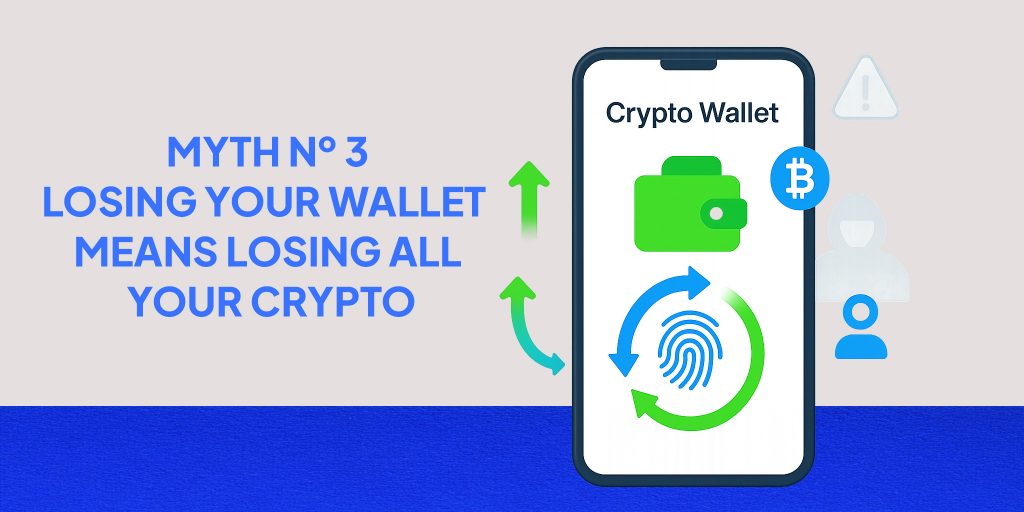
Lost your phone? Forgot your password? Device stolen? The panic hits immediately—your crypto must be gone forever. This fear drives one of the most dangerous myths in cryptocurrency: that losing wallet access means permanent loss.
What This Myth Claims
The myth says crypto wallets work like physical containers. Lose the container, lose everything inside. No recovery possible.
This creates massive anxiety because:
- People invest life savings in cryptocurrency
- No customer service exists to reset your password
- Headlines constantly report millions in permanently lost Bitcoin
An estimated $3.3 trillion worth of Bitcoin sits inaccessible due to lost private keys or seed phrases. These stories reinforce the fear that wallet loss equals total loss.
The Reality About Wallet Recovery
Your cryptocurrency doesn’t live inside your wallet. Your coins exist on the blockchain—a public ledger that runs independently of your device. Your wallet stores the cryptographic keys needed to access those blockchain assets.
Think of it like this: losing your TV remote doesn’t make your TV disappear. You just need another way to control it.
Recovery remains possible through several methods:
- Recovery phrases: Most wallets generate 12, 18, or 24-word seed phrases that restore complete access on any compatible device
- Alternative authentication: Advanced wallets offer multisig recovery, hardware security modules, social recovery systems, or biometric authentication
- Backup files: Some wallets create encrypted backups on external storage like microSD cards
- Professional services: Specialized companies can sometimes recover access, though costs are high with no guarantees
Wallet Recovery Protection Steps
Proper preparation turns potential disasters into minor inconveniences:
- Create multiple recovery phrase backups
- Write seed phrases on paper or engrave on metal—never store digitally
- Keep copies in multiple secure locations like safes or safety deposit boxes
- Verify backups regularly to ensure they remain intact
- Use diverse backup methods
- Combine physical and digital backup approaches when possible
- For hardware wallets, use both device-native backups and written recovery phrases
- Test recovery before you need it
- Practice the recovery process on new devices with small amounts first
- Learn your wallet’s specific recovery mechanisms
- Document recovery steps and store instructions with backup materials
- Plan for inheritance
- Create clear access plans for family members if something happens to you
- Consider social recovery systems with trusted individuals
- Include recovery instructions in estate planning documents
- Choose wallets with multiple recovery options
- Select wallets offering various recovery methods beyond seed phrases
- Consider multisignature wallets requiring multiple keys for transactions
- Explore wallets with biometric recovery capabilities
Remember: “Not your keys, not your crypto”. The inverse holds true—protect your keys properly, and your crypto remains accessible regardless of what happens to the wallet interface itself.
Losing wallet access becomes merely an inconvenience when you’ve prepared properly. Your cryptocurrency stays safe on the blockchain, waiting for you to regain access through your backup methods.
Myth 4: You Don’t Need a Wallet If You Use an Exchange
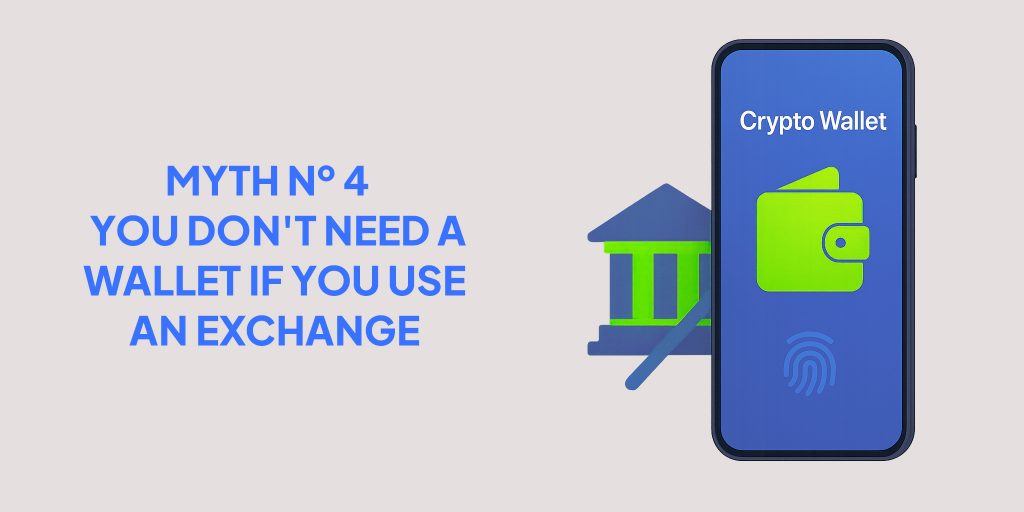
What the myth says about crypto wallets: You Don’t Need a Wallet If You Use an Exchange
The myth presents exchanges as complete cryptocurrency solutions. According to this belief, exchanges provide:
- All-in-one platforms for buying, selling, and holding crypto
- Built-in security that protects your investments
- Account recovery when you forget passwords
- Professional management without technical complexity
- Insurance coverage against potential losses
Why deal with seed phrases and private keys when exchanges handle everything? The user-friendly interfaces look just like banking apps—familiar and trustworthy. For newcomers, exchanges appear to solve cryptocurrency’s complexity problem completely.
The truth about crypto wallets: You Don’t Need a Wallet If You Use an Exchange
Here’s what exchanges don’t tell you: when your cryptocurrency sits on an exchange, you don’t actually own it. You have a claim to it—nothing more. The exchange controls the private keys, giving them ultimate control over your assets.
This creates serious vulnerabilities:
- Exchange Hacks: Between 2011 and 2021, hackers stole approximately $2.66 billion from exchanges worldwide.
- Insolvency Risks: Exchange bankruptcies happen regularly. Customers become unsecured creditors with limited recourse.
- Account Freezes: Exchanges can freeze your account during investigations, market volatility, or regulatory pressure.
- Withdrawal Restrictions: During high-traffic periods, exchanges often block access to your funds.
- Regulatory Action: Governments can force exchanges to freeze assets or hand over customer information without warning.
The cryptocurrency community has a saying: “Not your keys, not your coins.” Without controlling your private keys through a non-custodial wallet, you’re trusting a third party with complete control over your assets.
Exchanges also limit what you can do with cryptocurrency. Most don’t support staking, governance voting, or decentralized applications—core benefits that proper wallets provide.
How to protect your wallet: You Don’t Need a Wallet If You Use an Exchange
Balance exchange convenience with true ownership through these strategies:
- Use exchanges for specific purposes
- Converting between fiat and crypto
- Executing complex trades
- Accessing investment products
- Minimize long-term storage on exchanges
- Implement a two-wallet system
- Small “hot wallet” for active trading and immediate needs
- Secure “cold wallet” for long-term holdings
- This combines convenience with security
- Follow the 10% rule
- Keep no more than 10% of your crypto holdings on exchanges
- Transfer excess funds to your personal wallet regularly
- Establish withdrawal routines for larger holdings
- Research exchange security practices
- Look for cold storage practices and regular audits
- Check their track record for security incidents
- Verify insurance coverage and protection policies
- Secure your exchange accounts properly
- Use unique passwords and two-factor authentication
- Remember—these protect exchange access, not your actual cryptocurrency
- Monitor account activity regularly
Exchanges serve important functions for trading and converting cryptocurrency. Personal wallets provide true ownership and access to the full cryptocurrency ecosystem. The most secure approach uses both tools strategically—exchanges for their trading capabilities, personal wallets for actual ownership and control.
Myth 5: Backups Are Optional for Wallet Security
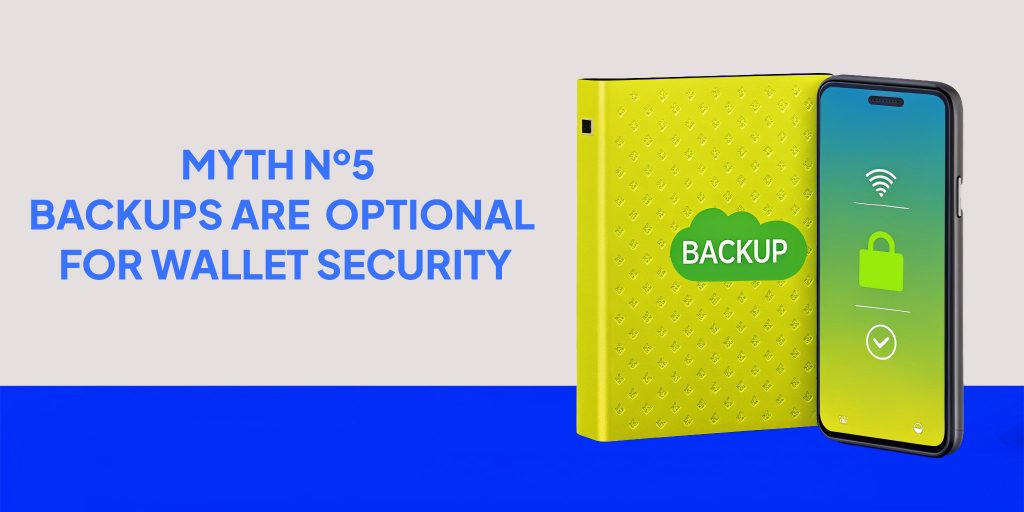
Think backups are just extra work? This dangerous myth has cost cryptocurrency holders billions in permanently lost assets. Your backup strategy isn’t optional—it’s the difference between temporary inconvenience and total financial loss.
What people believe about wallet backups
Most crypto users treat backups like insurance they’ll never need:
- “I’m careful with my devices, so backups are unnecessary”
- “My passwords are strong and my devices are safe”
- “Backups only matter for large holdings”
- “Exchanges and online wallets handle backup automatically”
- “Once I back up my wallet, I’m done forever”
This casual approach comes from misunderstanding how cryptocurrency works. People assume they can call customer support or recover funds through alternative methods when problems arise.
Why backups matter more than you think
Your backup isn’t a safety net—it’s your only lifeline. Without proper backups, even simple problems become catastrophic losses.
Consider these facts: Almost 20% of the total Bitcoin supply will likely never be recovered due to lost private keys. Device failures, theft, accidental deletions, and human errors have wiped out entire portfolios instantly. Unlike traditional banking, no central authority exists to help recover lost cryptocurrency.
Modern cryptocurrency wallets generate all keys from a single master seed. This master seed can create unlimited currencies, accounts, and addresses—making comprehensive backup both possible and essential.
Here’s what makes backups critical: your cryptocurrency exists on the blockchain, not your device. Your wallet stores the keys that prove ownership. Lose the keys, lose access to your funds forever.
How to protect your wallet with proper backups
Effective backup protection requires multiple strategies working together:
- Create multiple backup copies
- Make at least two separate backups of your wallet
- Store backups in different secure locations to prevent simultaneous loss
- Use both physical and digital backup methods for complete protection
- Choose the right backup materials
- Paper works but burns, tears, and fades over time
- Metal backups using stainless steel plates resist fire, water, and corrosion
- MicroSD cards offer digital storage for compatible hardware wallets
- Secure your backup storage
- Never store backups online, in cloud storage, or email
- Use fireproof safes or safety deposit boxes for physical backups
- Keep backup locations private and secure
- Test your backups regularly
- Check that backups remain readable and accessible
- Practice the recovery process with small amounts first
- Update backups when you make significant wallet changes
The effort required for comprehensive backups is minimal compared to losing access to your cryptocurrency permanently. Proper backup practices change potential disasters into minor inconveniences.
Your backup strategy deserves the same attention as your initial security setup. The question isn’t whether to backup your wallet—it’s how many backups you need and where to store them safely.
Your Wallet Security Checklist for 2025
Wallet security comes down to understanding what you actually own and how to protect it. Your crypto doesn’t sit inside apps or devices—it lives on the blockchain. You control access through private keys, not through customer service departments or password resets.
Here’s what matters most:
- Control Your Private Keys Exchanges hold your keys for you. Hardware wallets keep them offline. Mobile wallets store them on your device. Choose based on how much control you want and how much risk you’re willing to accept.
- Backup Everything That Matters Write down your seed phrase. Store it somewhere safe. Make multiple copies. Almost 20% of Bitcoin is lost forever because people skipped this step.
- Use the Right Tool for Each Job Keep spending money in mobile wallets. Store long-term holdings in hardware wallets. Use exchanges for trading, not storage. Match your security level to your risk level.
- Plan for Recovery Test your backups before you need them. Make sure someone you trust can access your crypto if something happens to you. Document your recovery process.
- Stay Updated Security features improve constantly. Update your wallet software. Review your backup strategy. Check your security settings regularly.
The cryptocurrency market changes fast, but these security basics remain constant. Get them right now, and you’ll protect your assets regardless of what happens next.
Your crypto security doesn’t need to be perfect—it just needs to be better than leaving everything on exchanges or hoping nothing goes wrong.
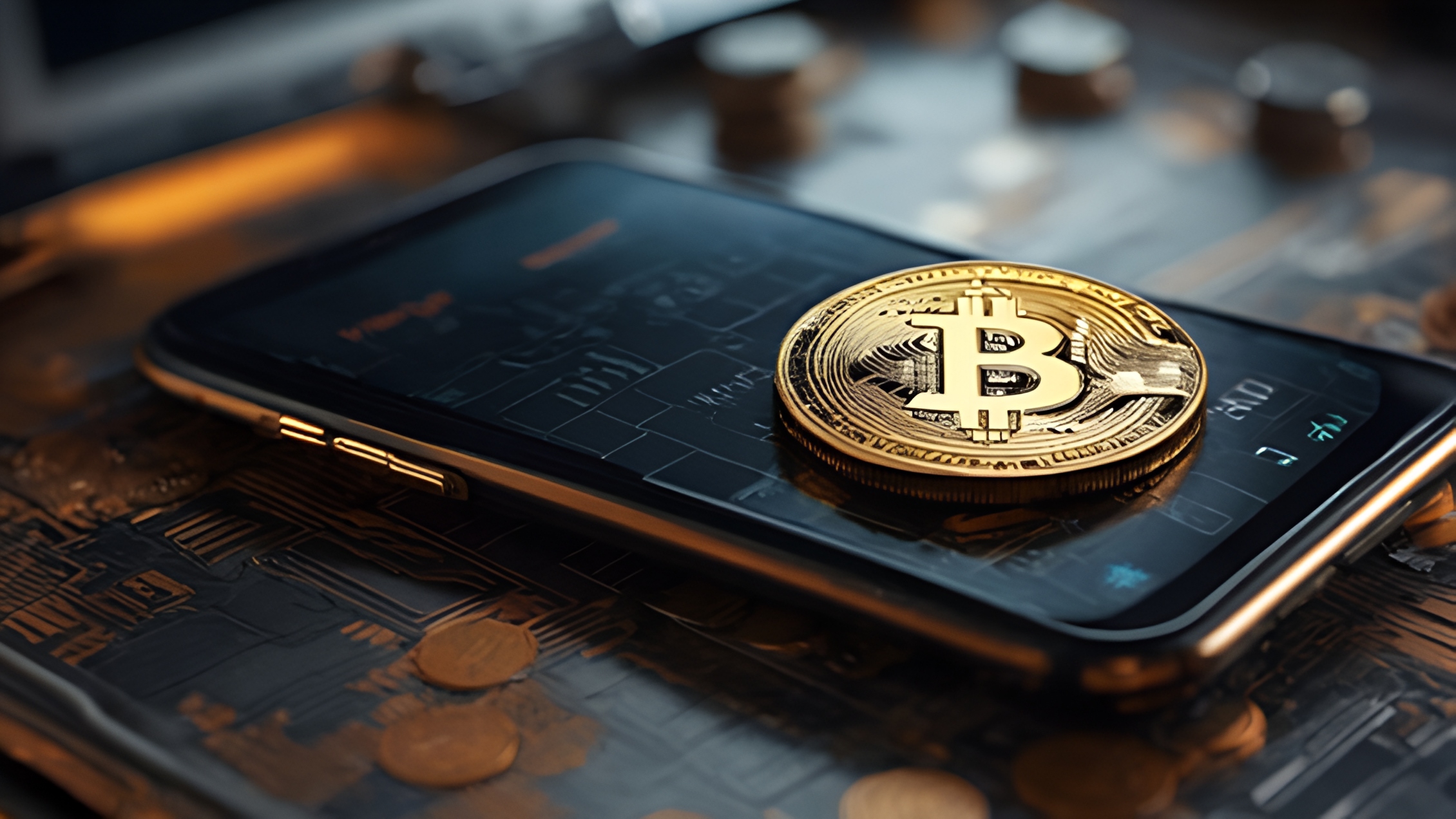
Leave a Reply